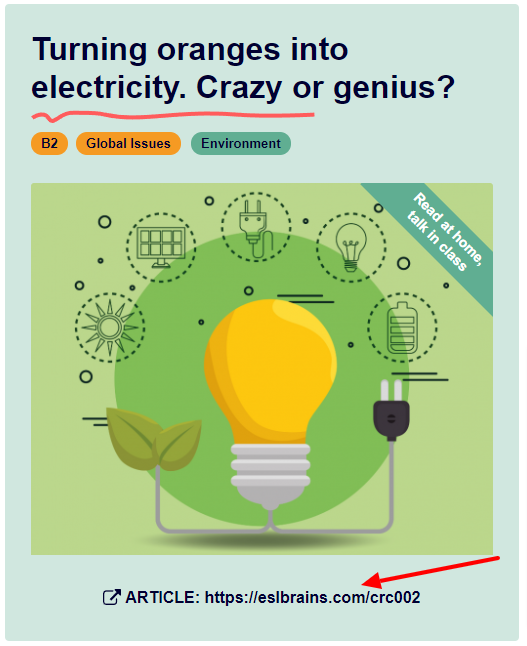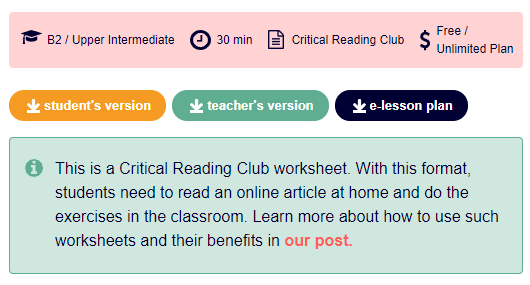We’re happy to announce that we are going to create new teaching materials with you: the Critical Reading Club (CRC) worksheets. They are available in addition to all the regular ESL Brains lesson plans on our website, so there will be more worksheets for you to use every month.
The idea behind the worksheets is that students read an article before the class and then discuss its content and share their thoughts in the classroom. Previously, we only shared articles and a few discussion questions on our Instagram account. Thanks to your active participation and feedback, we’ve been able to develop these brand new CRC worksheets.
How does CRC work?
It’s very simple. Before each lesson, you just need to visit the ESL Brains website and copy a link to an article for your students to read.

Then, share the link with your class and set the reading task as homework. The ‘in-class’ part is based on a short worksheet, which typically contains four or five tasks related to the content of the article. The activities focus on some relevant language followed by speaking practice, and they take about 30-45 minutes to complete. It might actually take longer, as learners tend to get highly engaged with some topics!
The articles we curate for every lesson are authentic texts published by reputable online news resources (not adapted!). These original, up-to-date materials in English not only spark discussion, but also serve as a rich source of new language for students to learn. The CRC worksheets do not contain reading comprehension questions such as those often found in ESL course books. Instead, their purpose is to inspire critical discussion while at the same time improving students’ speaking fluency. Each CRC lesson is available in the form of printable worksheets (both teacher’s and student’s versions), as well as an e-lesson plan.

Why should you get your students involved in CRC?
We’re all aware of the benefits of continuous reading practice whilst learning a foreign language. It stimulates the brain, increases vocabulary and even helps develop writing skills. However, there is often too little time for learners of English as a foreign language to read long texts and do extensive comprehension activities in class. Although we recognise the invaluable role of the teacher in helping students acquire reading skills, we have decided to focus on boosting students’ motivation to read outside the classroom. We want to achieve this goal by selecting interesting and thought-provoking texts as well as designing stimulating questions for in-depth discussions.
How does this lesson model benefit students?
- It helps you make the most of every minute of lesson time. Each class should give students the feeling of having learnt new language while maximising their speaking opportunities.
- Being able to tackle authentic texts in English will result in enhancing students’ self-esteem and create more interest in exploring the English language and culture on their own. (Just remember, it is your job as a teacher to make sure your students’ language level matches the level of the article you want them to read, so they don’t get frustrated.)
- The ultimate goal is for students to become autonomous, self-motivated language users, in charge of their own learning process.
What if students don’t do the prep work?
There’s no reason to skip out on Critical Reading Club worksheets if students don’t read an article. You can pair up students, letting those who’ve done the reading summarize for those who haven’t. And if nobody cracks open the article, you can adjust exercises based on extra tips we offer in some worksheets. You can also engage students by making them guess the article’s content from the title which is often sufficient for them to do the rest of the tasks. And our topics are so captivating students will jump into discussions even without knowing all the details of the article. Over time, showing up unprepared might lead students to realize the value of completing readings, nudging them to own their learning journey.
You can see all the worksheets here. We wish you lots of exciting and stimulating lessons with our Critical Reading Club!















thank you, this new series of lessons is super inspiring!!
Thanks 🙂
Is there an option to just see these CRC lessons? If not, could you make one so we don’t have to scroll through all different types. This would be great if you could do it for all the different types, e.g. speaking etc. It’s something that I want to find quickly but can’t.
You can filter the lessons by their type. This filter is available after clicking “show more filters” in the Lesson Search page. Read about more ways to browse through ESL Brains lessons here.